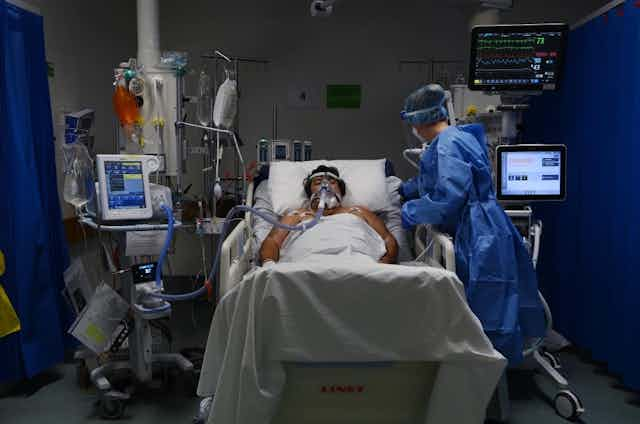Rising COVID cases in several Australian states means demand for intensive care unit (ICU) beds and specialist critical nurses will rise.
This increase in demand is on top of the typical workload ICUs might see.
And because of the nature of COVID itself and other factors, this puts pressure on the entire hospital system.
Read more: How are the most serious COVID-19 cases treated, and does the coronavirus cause lasting damage?
What happens in ICU?
The ICU is where we care for the most critically unwell patients, where treatments are designed to support breathing and circulatory problems affecting the heart, blood, or blood vessels.
The most unstable and sickest ICU patients require airway support in the form ventilation to help them breathe. They also need circulatory support in the form of drugs to improve blood pressure and heart function.
Patients come to ICU as a planned admission (for example, after a complex operation), or as an emergency admission (for example, after a serious car accident).
Read more: ICU ventilators: what they are, how they work and why it's hard to make more
Patients stay for, on average, three days in ICU before recovering enough to be moved to a ward, or sadly, dying.
Because patients in ICU are unstable and critically unwell, there is usually one nurse to care for each patient. This is a highly skilled job. Most ICU nurses have extra postgraduate qualifications.
COVID changed the type of patients we see
Patients who are critically ill with COVID are often sicker than other ICU patients and may require more support for their breathing and circulation. Often, they need to stay in ICU longer than other patients.
This creates challenges for hospital systems, because beds in ICU become blocked, and planned operations may be cancelled because of the lack of ICU beds.
Once patients with COVID no longer need ventilation or circulatory support, they are transferred to the ward for additional care. They may have experienced painful procedures and have a degree of physical impairment.
They may also have witnessed a number of stressful events in the ICU, such as emergency resuscitation procedures and deaths, which may increase the risk of post-traumatic stress disorder, anxiety, and depression.
Although we don’t have definitive long-term data, patients who have been critically ill from COVID often have a long and difficult journey of recovery and will likely remain dependant on health care services for some time.
Read more: Younger adults can get very sick and die from COVID too. Here's what the data tell us
COVID changed how we nurse
ICU staff looking after COVID patients have the additional demands of working in full personal protection equipment (PPE), which can be hot and uncomfortable and very challenging to work in.
The need to use PPE correctly, and the constant concern about becoming infected or dying if there’s an infection breach, adds to nurses ongoing stress.
The International Council of Nurses’ latest analysis shows the number of nurses who have died after contracting COVID-19 globally is greater than 2,200 – more than any other health-care worker. This data are from earlier this year, so we expect those figures to have risen since then.
COVID challenges Australia
In Australia, there has been more time to respond to the challenges of COVID. In many states, the numbers of ventilators increased, models of care were developed for COVID-positive patients, and snap lockdowns ensured scarce ICU resources were not overwhelmed.
However, the increasing number of positive cases in New South Wales in particular, coupled with the highly infectious Delta variant, means ICUs risk reaching capacity.
At the time of writing, 109 patients were in Australian ICUs and 37 of these patients required ventilation.
Australia has 191 ICUs with 2,378 beds and the capacity to increase this by by up to 4,258 beds. But there may not be enough specialised nurses or equipment match this bed increase.
Surge capacity also varies between ICU categories and jurisdictions, with tertiary hospitals reporting more capacity. So deteriorating patients may need to be air-lifted to major metropolitan or regional centres.
Read more: Does anyone know what your wishes are if you're sick and dying from coronavirus?
What can happen in the future?
Fortunately, public health measures have meant Australia has been spared the horrors of countries that were unable to successfully increase their ICU resources to meet demands, for example, Spain, Italy and the United Kingdom.
Yet, hospitals are still feeling the impact of a rise in critically unwell COVID patients in many ways, and will do so in the future.
Undergraduate student nursing placements, for example, have been delayed and many universities have moved their education online. So student nurses may struggle to achieve the clinical hours required to graduate. This may mean a shortfall of clinically competent and educated ICU nurses in the future.
The best we can do
So the next time you hear the latest number of COVID patients in ICU, think of what’s behind those numbers and what this means for the whole hospital system and its staff.
Protect them, yourself and others by sticking to the public health advice, including getting tested with the mildest of symptoms. Most importantly, get vaccinated. People fully vaccinated against COVID rarely end up in ICU.

